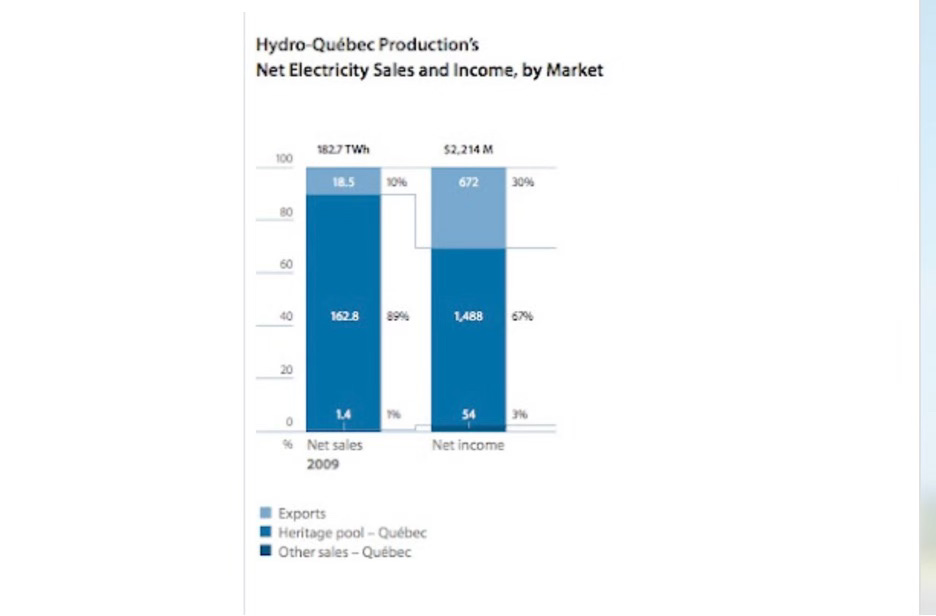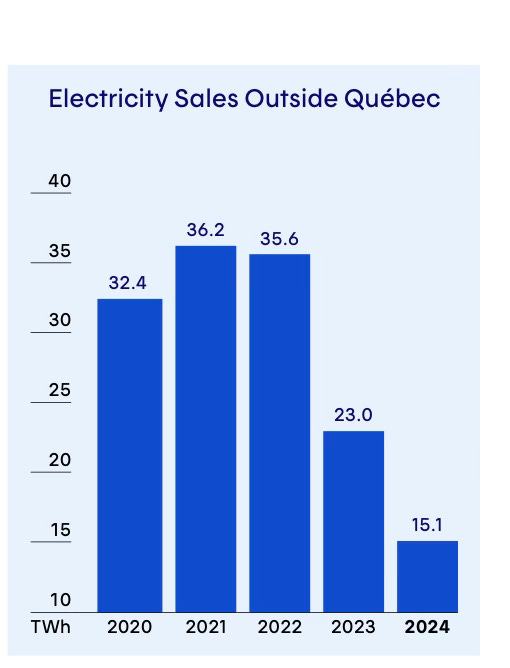Blue Flag, Official Wildflower of Québec1
Local Flowers and Hydro Power
Do you ever wish SO HARD that you kept something that you had discarded? I do. I wish I still had the lavishly illustrated book that Hydro-Québec gave me in 1977.2
In 1977, I had a consulting agreement with the transmission group at the Electric Power Research Institute (EPRI). In the course of that contract, I visited the Hydro-Québec research lab just outside of Montreal.
Hydro-Québec was renowned for its excellent high-voltage test facilities. EPRI wanted me to report on how their test facilities would work for some of the EPRI projects. (This consulting gig also led to me being co-inventor on a patent about underground electrical equipment.)
But there was something odd about the trip. HQ wanted me onsite on a certain day. This was unusual. On most of my trips, the company I was visiting had more general opinions of what days would be good for me to visit. Whatever the reason, it was easy enough to arrange my trip to be in Montreal on the day they wanted me to be there.
I found out the reason around noon when I was in Montreal. I had to “go to the main meeting room” for lunch because the “buses had arrived.” The buses had probably arrived from the airport. They carried investors who had visited the James Bay project.
At any rate, I went downstairs for lunch. What a lunch! Everywhere I looked, there were large bouquets of local wildflowers. The food was spectacular. Maple liqueur was served after lunch. I wasn’t used to this sort of thing. When visiting a lab, I usually shared a platter of sandwiches in somebody’s office. At HQ, I was at a table with bankers, insurance executives, and fund managers. With a bouquet of wildflowers in the middle of the table.
I was much younger, and I was practically tongue-tied. Then I was introduced to the whole room. “This is Meredith Angwin from EPRI. We hope to get several contracts with her organization.” I managed to stand up, smile, and sit down again. Thank goodness I didn’t have to say anything. I don’t know how much Meredith-from-EPRI impressed the bankers. However, “income from many sources” is usually worth telling your bankers about.
Oh yes, I forgot. Everyone at the luncheon received a lovely HQ book about the James Bay project plans. It was lavishly illustrated. I wish I still had that book.
Regrets. I’ve had a few…..
Endless Power
In those days, the 1970s and early 1980s, the potential hydro power from Québec seemed endless.3 When I visited HQ in 1977, the biggest hydro station of all, Robert Bourassa, was close to going online. Bourassa is 5616 MW and 16 units: it went online between 1979 and 1981.
The early days of Hydro-Québec were wild and wooly. Too wild and wooly. The mood was rather like the statement by Judge Roy Bean, who declared he was the Only Law West of the Pecos. I think that HQ considered itself the only law north of the Rupert River.
Let’s look at how the early days in HQ affected various groups in Québec.
Power and People in Québec
Québec is huge. It is twice the size of Texas and slightly larger than Alaska. Most of the people in Québec live in the relatively urbanized areas in the southern part of the province. The northern area of Québec is the traditional home of the indigenous people. How did the HQ projects affect these groups?
Indigenous people: In the early years of the HQ project, the indigenous people saw many of their hunting areas drowned by the dams. They were not consulted. Heck, as far as I can tell, they weren’t even told. The Cree found out about the hydro plans when they noticed bulldozers coming to their territory.
The Cree fought the project in court, and partially won. Only partially. The Cree couldn’t stop the first part of the James Bay project; the project continued even while the court case was being heard. However, due to public outcry, in 1994, Hydro-Québec had to cancel a later part of the project: hydro plants at La Grande Baleine. Much later, in 2004, the indigenous people were included in the environmental assessment of a smaller project, the Rupert River Diversion. The Rupert project was constructed.
Here's a 2-minute video of HQ testing at the Bourassa project in 2018. I hope it gives an impression of the size of this project. Opening of the spillway gates at Robert-Bourassa generating station
Non-indigenous people: Most of the southern portion of Québec is a mixture of farmland, small towns, and cities. To be blunt about it, this is where the Québec voters live. It has a much higher population than the northern forests.
How do you persuade voters that your province has to borrow a bunch of money to build infrastructure? You do it the old-fashioned way. You show that the infrastructure will be an economic benefit to the voters.
In this case, the hydro projects would lower taxes and provide abundant inexpensive electricity. The hydro system is owned by the Province of Québec, and its profits go to the coffers of the province. This lowers the tax burden on the people of Québec.
Meanwhile, the people within Québec were guaranteed low electricity rates as part of the Heritage Pool requirements. To quote Hydro-Québec:
In 2000, the Québec government designated the energy produced by hydroelectric plants built in the last century as the “heritage pool.” The Generator must supply this energy to the Distributor at a highly competitive price, thus guaranteeing affordable electricity to all Québec customers….The heritage pool amounts to 165 TWh, which in 2018 represented roughly 90% of Québec’s annual electricity consumption.
One consequence of this policy has been that the average customer in Québec uses about three times the electricity of the average customer in New England. Yearly per capita electricity use in Québec is approximately 23,000 kWh, while the New England use is approximately 7,500 kWh. People in Quebec (like people in Norway) tend to use electricity for home heating.
Another consequence of the Heritage Pool policy is that HQ can’t make much profit on its sales of electricity within the province. Which brings us to exports.
Exports
In 2010, “importing from Quebec” was one of Vermont’s big plans for “after we shut down the Vermont Yankee nuclear plant.” I defended the operation of Vermont Yankee in my blog, Yes Vermont Yankee. Therefore, I often wrote about HQ. One of my posts was You Better Be Good to Your In-State Customers. That post included this chart from the HQ annual report of 2009. You can see that HQ exported 10% of its electricity and made 30% of its revenue on those exports.
More recently, the export situation has changed. Pages 12 and 15 of the HQ annual report for 2024 are the most relevant. In 2024, HQ sold 181 TWh of electricity within Québec and exported 15 TWh (196 TWh total). It made $1.5 billion (Canadian) in 2024 from export sales compared to $14.0 billion from Québec electricity sales.
For a rough calculation, in 2024, HQ exported 7% (15 over 196) of the electricity it produced and made 10% of its revenue on those sales. In fairness to HQ, this was a particularly low export figure, as shown in this chart, from page 16 of the 2024 annual report. Québec has had several dry years with low water flow.4
.
Gaining 10% of revenue on 7% of sales (exports) is nothing like the Good Old Days of 2009, when HQ made 30% of its revenue on the 10% of its sales that it exported. Québec also sells makes money on sales of Renewable Energy Certificates. However, it can sell RECs separately from selling the electricity.5
I would also be remiss if I didn’t note that HQ sometimes gets crunched for electricity in the winter. Québec sometimes needs to import power from New England and Ontario. I am not going to follow this issue in this post. It would be a completely new blog post.
Numbers and Opinions
What does HQ itself say about its export situation? Its statements seem inconsistent.
In May 2023, HQ was challenged by Maine legislators. They were concerned that HQ would not have enough electricity to meet its obligations to Maine. HQ’s chief financial officer, Jean-Hugues Lafleur said that they had enough electricity. As reported by Marisa Coulton in the Financial Post:
On an analyst call on May 12, 2023 Lafleur said
“When we signed the contract in 2018, we had enough energy and we still have enough energy to supply the New England region.”
Meanwhile, amid “soaring industrial demand,” the province has slowed new development within Québec.
As Frédéric Tomesco wrote in the Montreal Gazette on March 30, 2024. “In 2023, Québec tightened approval criteria for new projects in 2023 amid soaring industrial demand. Under the new rules, any project requiring at least five megawatts of power must be approved by the provincial government. Until last year, the threshold was 50 megawatts.”
Into the future:
At this point, Québec plans to meet its export obligations but build new facilities that supply in-province energy. I think this is very wise. If you sell electricity on the market, your only benefit is whatever price you might receive for it. If you use electricity locally, you get more benefits. You can build your economy by attracting good jobs.
My prediction is that the “Northern Countries Export Electricity” story is fading. In my opinion, any country that depends on Norway, Québec or Sweden to supply their power will be disappointed in the long run
I advise any young man, young woman, or young industry to Go North. Inexpensive reliable electricity is extremely valuable to a country, and the northern countries will no longer be giving it away.6
Northern countries are beginning to value their local power plants, as well as their local wildflowers.
Postscript on Tariffs!
I began this post several weeks ago. (I have had some health problems in the meantime.) When I went back to it, I thought the post might need a total rewrite due to possible new tariffs on Canadian electricity. Here’s a good article about the tariffs from Robert Walton at Utility Dive.
However, on rereading my post, I realize that the tariffs change will not change much in the New England area. Québec is not interested in increasing their electricity exports.
Québec doesn’t make much money from the exports, compared to what they used to receive in the old days.
Québec understands that using the electricity in Québec grows their own economy.
Using the electricity in Québec also makes the province less vulnerable to decisions made in another country.
In other words, I determined that publishing this post would still be worthwhile.
Blue Flag graphic: Nichole Ouellette/ouellette001.com - Own work
Yeah. I am in my seventies. Don’t bother calculating it.
Hydro-Québec has a very helpful table of their generating stations.
Appreciation to Richard Norris for advice and assistance on this post. Norris writes the Pandreco Energy IQ substack. Of course, any errors in this post are my own.
In the 2024 report, a separate sales item for HQ in was a year-over-year increase of $62 million to HQ, primarily due to higher sales of Renewable Energy Certificates. As HQ states: “These certificates provide proof of exclusive ownership, granted to a third party by Hydro-Québec, of the environmental attributes associated with the use of 100% renewable energy.” (Page 17 of HQ annual report.)
See my post on how Norway feels about electricity exports, Go North Young Man or Young Woman. Also read Kathryn Porter’s recent post on how Norway is Turning Away from Electricity Interconnections.







Mrs Angwin
I am a regular (I can even say faithful) reader of your Substack posts but, there are two reasons why I was specially interested in the current post; the first reason is that I am a Canadian citizen residing in Montreal and the second is the fact that I have also posted a document on Substack whose title says a lot by itself:
“Hydro-Québec and the New York and New England contracts, Selling electricity it does not own at a cost it does not know.” I have taken the liberty of including a link to that post at the end of the present comments but briefly here is the bottom line:
- The post deals with the importance of Churchill Falls, a 5,428 MW facility located in the province of Newfoundland and Labrador; it’s the second largest facility in Canada right after the Robert-Bourassa quoted in your text but Churchill Falls has a much bigger reservoir.
- Due to a contract signed in 1969, Hydro-Québec has access to basically 100% of the annual 30 to 35 TWh production at a cost of 2 mills per kWh (this is not a mistake, this is $0.002 per kWh). Over the last 10 years basically all of the Churchill Falls output has been exported, mostly on the spot market, the only exception being years of low rainfall in Québec; in such cases HQ simply closes the export valve in order to respect the “Heritage Pool” requirements quoted in your text.
- This contract expires in 2041 but in the mean time HQ has signed fixed term annual export contracts of approximately 10 TWh each with New England and New York that have a duration of 20 years in one case and 25 in the other, thus extending past 2041 after which no one really knows how much these 20 TWh will cost or even where they will comme from.
- After my text was posted there have been direct negotiations between the governments of Québec and Newfoundland and Labrador that have resulted in the signature of a Memorandum of Understanding between the two parties; but many, many details have to be negotiated before reaching final numbers; and the Prime Minister of Newfoundland and Labrador has resigned a few weeks ago.
That’s it for the bottom line on Churchill Falls but I am also working on another post dealing with HQ’s 2035 development plan.
Hoping this is useful
https://raison.substack.com/p/hydro-quebec-and-the-new-york-and
I'd like to know how Hydro Q's RECs compare to RECs sold by wind farms. In New York, the price of Tier 1 RECs in 2024 ranged from $31.78 to $36.37 per MWh. NYSERDA, “2024 Compliance Year”, available at <https://www.nyserda.ny.gov/All-Programs/Clean-Energy-Standard/LSE-Obligations/2024-Compliance-Year>. A 340 MW wind farm's annual generation rate (340 MW X 8,670 hrs./yr. X 25% capacity factor) results in annual revenue from the sale of RECs of $25,316,400.00.